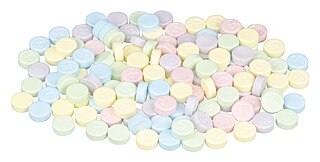
Oreo is a brand of sandwich cookie consisting of two cocoa biscuits or cookie pieces with a sweet fondant filling. It was introduced by Nabisco on March 6, 1912, and through a series of corporate acquisitions, mergers and splits both Nabisco and the Oreo brand have been owned by Mondelez International since 2012. Oreo cookies are available in over one hundred countries. Many varieties of Oreo cookies have been produced, and limited-edition runs have become popular in the 21st century.

A wedding cake is the traditional cake served at wedding receptions following dinner. In some parts of England, the wedding cake is served at a wedding breakfast; the 'wedding breakfast' does not mean the meal will be held in the morning, but at a time following the ceremony on the same day. In modern Western culture, the cake is usually on display and served to guests at the reception. Traditionally, wedding cakes were made to bring good luck to all guests and the couple. Nowadays, however, they are more of a centerpiece to the wedding and are not always even served to the guests. Some cakes are built with only a single edible tier for the bride and groom to share, but this is rare since the cost difference between fake and real tiers is minimal.

J. Lyons & Co. was a British restaurant chain store, food manufacturing, and hotel conglomerate founded in 1884 by Joseph Lyons and his brothers in law, Isidore and Montague Gluckstein. Lyons’ first teashop opened in Piccadilly, London in 1894, and from 1909 they developed into a chain of teashops, with the firm becoming a staple of the High Street in the UK. At its peak the chain numbered around 200 cafes. The teashops provided for tea and coffee, with food choices consisting of hot dishes and sweets, cold dishes and sweets, and buns, cakes and rolls.

Terry's Chocolate Orange is a chocolate product created by Terry's in 1932 at Terry's Chocolate Works in York, England. The brand has changed ownership several times, and production was moved to Poland in 2005. Since 2018, the Terry's Chocolate Orange has been produced in Strasbourg, France, by Carambar.

Cadbury Creme Egg, originally named Fry's Creme Egg, is a chocolate confection produced in the shape of an egg. It originated from the British chocolatier Fry's in 1963 before being renamed by Cadbury in 1971. The product consists of a thick chocolate shell containing a sweet white and yellow filling that resembles fondant. The filling mimics the albumen and yolk of a soft boiled egg.

Tastykake is a line of snack foods manufactured by the Tasty Baking Company, headquartered at the Philadelphia Navy Yard in Philadelphia, Pennsylvania. Established in 1914 by Philip J. Baur and Herbert T. Morris and originally selling its product only in the Philadelphia metropolitan area, the company now distributes its products in several states on the East Coast, south to Florida, and has been gradually expanding across the United States.

After Eight Mint Chocolate Thins, often referred to as simply After Eights, are a brand of mint chocolate covered sugar confectionery. They were created by Rowntree Company Limited in the UK in 1962 and have been manufactured by Nestlé since its acquisition of Rowntree in 1988.

SweeTarts are sweet and sour candies invented under the direction of Menlo F. Smith, CEO of Sunline Inc., in 1962. The candy was created using the same basic recipe as the already popular Pixy Stix and Lik-M-Aid products.

RHM plc, formerly Rank Hovis McDougall, was a United Kingdom food business. The company owned numerous brands, particularly for flour, where its core business started, and for consumer food products. It was listed on the London Stock Exchange and was once a constituent of the FTSE 100 Index but was acquired by Premier Foods in March 2007.

Slice was a line of fruit-flavored soft drinks originally manufactured by PepsiCo and introduced in 1984 but discontinued by PepsiCo in North America in the late 2000s. Slice was reintroduced in the United States and Canada as a brand of Organic food by "New Slice Ventures LLC", which acquired the trademark rights in those countries.

The frog cake is an Australian dessert in the shape of a frog's head, composed of sponge cake and cream covered with fondant. It was created by the Balfours bakery circa 1923, and soon became a popular treat in South Australia. Originally frog cakes were available exclusively in green, but later brown and pink were added to the range. Since then other variations have been developed, including seasonal varieties. The frog cake has been called "uniquely South Australian", and has been employed in promoting the state. In recognition of its cultural significance, in 2001 the frog cake was listed as a South Australian Heritage Icon by the National Trust of South Australia.

Premier Foods plc is a British food manufacturer headquartered in St Albans, Hertfordshire. The group owns many well-known brands, including Mr Kipling, Ambrosia, Bird's Custard, Angel Delight, Homepride cooking sauces, Lyons, Sharwood's, Loyd Grossman sauces, Oxo, Bisto, Batchelors and Plantastic. Premier Foods also produce cakes under the Cadbury's name, using the brand under licence. It is listed on the London Stock Exchange and is a constituent of the FTSE 250 Index.

ReaLemon is an American brand of lemon juice that debuted in 1934, and is manufactured and marketed as of 2016 by Mott's, part of Keurig Dr Pepper. ReaLime is a brand of lime juice that debuted in 1944, is produced in the same manner as ReaLemon, and is also produced and marketed by Mott's.

A dessert sauce is a sauce used for desserts. It is drizzled or poured atop various desserts, and is also used for plate decoration. Dessert sauce adds flavor, moisture, texture and color to desserts, may be cooked or uncooked, and is sometimes prepared as a hard sauce with the addition of alcoholic beverages. It is used in various manners to add flavor to and enhance the visual presentation of desserts.
The first season of The Great Canadian Baking Show premiered on CBC Television on November 1, 2017. Ten amateur bakers competed over eight weeks of challenges throughout the competition for the title.













